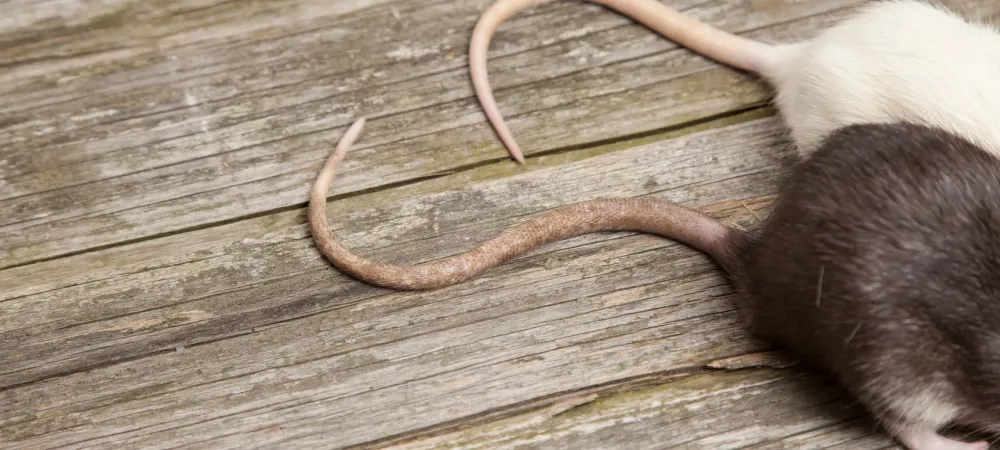How to Get Rid of Rats & Mice

No one wants to share their home with rats and mice. And for obvious reasons—they cause damage to homes, can carry diseases, and contaminate food in your pantry. If you’ve discovered these furry critters in your home, here are a few tips and tricks that can help you get them out and keep them out.
What Attracts Rats To Your Home?
Like us, rats and mice need food, water, and shelter. Though they are resourceful creatures that can make their way in forests and fields, the ease of access to food, water, and shelter in a human home is a very attractive living situation for them.
Why Are Rodents Dangerous?
The main perils that rodents present are their tendency to carry diseases that can harm humans. These include hantavirus, and hemorrhagic fever, which can both be contracted by inhaling dust contaminated by rodent droppings or urine, according to the Centers for Disease Control and Prevention. Other diseases, such as salmonellosis and rat-bite fever come from eating or drinking water contaminated by rat droppings. None of these diseases is a walk in the park if contracted, requiring hospitalization and potentially being fatal.
Do Rats Bite?
The short answer is that they can. A more nuanced answer is that rats generally bite when they have no other option. As the adage goes, they are more afraid of you than you are of them. A rat’s MO when humans are present is to run and hide, both of which they are adept at. If, however, a rat is cornered, it will turn to aggression to try to escape.
This is why rat removal by a professional exterminator can be so important to protect your and your family’s health. A good rule of thumb if you encounter a wild rat is to not attempt catching it with your hands (a live trap or snap trap is a different story) because this is the most likely way to get bitten. This can often lead to contracting rat-bite fever and having to go to the hospital.
Common Types of Rodents in Washington
Common rodents of Washington include Norway Rats and Black Rats, both of which are referred to as Old World Rats because they stowed away in the first colonial ships from Europe to the Americas, according to the Washington Department of Fish and Wildlife. These two rats now exist anywhere humans do.
Washington is home to 12 native species of mice, including the field mouse, Northern Grasshopper Mouse, and the Great Basin Pocket Mouse. However, the most common species and the main culprit of home infestations is the House Mouse, also an introduced species from Europe.
Signs of a Rat infestation
Tell-tail (pun intended) signs often betray a rat problem in a home. These include:
- Strange noises and smells: These can be heard in the walls and attic, or scattering along the floor.
- Footprints: Rat footprints might be visible if they step in something colored, but if you think rats are afoot, you can also sprinkle baking soda along the bases of walls so that you can see rat tracks.
- Droppings: Rat droppings look like little pellets just a touch bigger than rice grains.
- Smears: Rats tend to travel along baseboards because they have poor vision. The repeated travel leaves streaks of grease and dirt where their fur brushes against the wall.
- Damage: Along with nibbling on food in your pantry, rats will gnaw on wires, and eat any food not securely stored away.
If one, or a combination, of the above, is true in your home, you likely need to look into some form of rat removal.
When Are Rodents Most Active?
Most rodents are nocturnal, so they do most of their foraging from dusk to midnight. This is why you might see neither hide nor tail of these critters during the daytime, then hear them all over your house as you lie in bed. Rats and mice have poor vision, so being active at night levels the playing field between them and their predators.
Rodent activity is generally heightened in the summer and fall because they are storing food for the winter. And as winter’s chill creeps in, mice and rats will work harder to find warm nesting areas, i.e. your home. Although other pest problems often recede with oncoming winter, mice and rat problems tend to rise around this time of year.
How to Keep Rats Out
A number of simple practices will help you keep rats out of your home in the first place. In a nutshell, you do this by making your home uninviting to these opportunistic rodents. If you don’t have any rat problems, these are steps you’ll want to take to ensure things stay that way around your home!
Simple ways to keep rats out of your home:
- Seal up your home’s exterior: Holes in the siding, foundation, or roof of your home are like a giant “Vacancy” sign for rats seeking shelter. Sealing these up with plywood, expanding spray foam, wire mesh, or via general repairs will make your home that much less accessible.
- Keep your yard and home exterior tidy: Cutting branches that grow too close to your roof will remove one way that rats could access the top of your house. It’s also important to remove any leaf/debris piles in your yard, keep your garbage in sealed cans, and have your woodpile far from your house. All these measures reduce the number of shelter options for rats outside your house that could help them find ways inside your house.
- Keep your home’s interior decluttered and clean: Regular sweeping and/or vacuuming will remove crumbs from the floors that attract rats. Similarly, wiping down countertops and quickly cleaning up after spills will reduce the food available for rats.
- Store food in rodent-proof containers: This includes pet food! If food in your pantry is simply inaccessible to rats, they won’t have much reason to stick around.
- Prevent pooling water inside and outside: Water is the most limiting factor for rats, so minimizing the amount readily available for them to drink is key. This means repairing leaky faucets, dumping containers in your yard that might catch rainwater, and not leaving a pool of water in your sink.
How to Get Rid of Rats in Your Home
While rat prevention will make your home less attractive to prospecting rats, if they've already moved in, you need rat removal—and fast. With such a rapid breeding rate, getting rid of quickly will reduce the number you have to deal with as well as the amount of damage to your home. You can remove rats in various ways, ranging from simple DIY methods to calling in the trained professionals at Sound Pest Control.
Rat removal techniques:
- Set traps: These can be traditional snap traps, or live traps if you prefer not to kill rats. Place these along with routes rats often use, such as along the base of a wall. Peanut butter is a cheap attractant for rats. For live traps, make sure you release trapped critters upward of 5 miles away because they can find their way back to their nest from several miles away.
- Use dry ice: A more “mad-scientist” approach to rat removal would be to place dry ice next to rat holes or nests. Dry ice is the solid form of carbon dioxide, so when it sublimates, it will replace the oxygen around a rat, putting it to sleep then killing it by asphyxiation.
- Place bait and poisons outside: Although it’s an option to poison rats, you don’t want to do this inside your house because there is a chance rats move the bait around, potentially endangering your family and pets. Be sure to read all instructions carefully if you choose this route, because rat poison is capable of killing a lot more than rats!
- Get professional help: By far the most sure-fire way to get rid of rats is to contact a professional like Sound Pest Control. We’ve dealt with literally hundreds of separate rodent infestations, and have learned a lot about the quickest and most effective modes of rat control. If you want to save time and headaches, this is the way to go. Contact us today to speak with our team of local experts!
